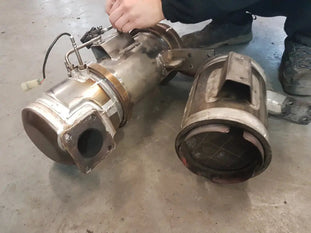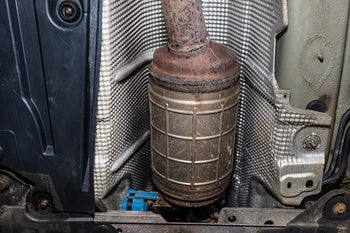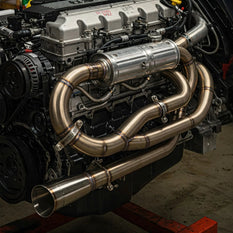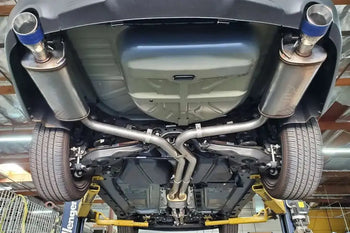Unlock Peak Perfo...
Aug 15, 2025
Unlock the true potential of your 2018 6.7 Cummins with a powerful DPF delete kit. Discover how removing restrictive emissions components can dramatically improve horsepower, fuel efficiency, and engine life.
If you drive a diesel vehicle, you’ve likely heard of a Diesel Particulate Filter (DPF). But what exactly is it, and why is it so crucial for both the health of your vehicle and the environment? This blog will answer these questions, break down the purpose of a DPF, and explore why it’s essential to your vehicle’s performance. We’ll dive into common issues that arise with DPFs, how to maintain them, and what happens when they fail. Keep reading to ensure your vehicle stays in top condition while meeting environmental regulations! What is a Diesel Particulate Filter (DPF)? A Diesel Particulate Filter (DPF) is a key component in modern diesel engines designed to reduce harmful emissions. It works by capturing and storing particulate matter (PM), which consists of fine particles such as soot and carbon. These particles are produced during the combustion process in diesel engines and can be harmful to human health and the environment if not properly filtered. The DPF acts as a filter in the exhaust system, trapping these particles before they can be released into the air. Over time, the trapped particles need to be removed through a process called regeneration, which burns off the soot and turns it into ash that is safely released through the exhaust. How Does a DPF Work? In a diesel engine, the fuel is burned at a higher temperature than in gasoline engines, producing more particulate matter (soot) as a byproduct. The DPF collects this soot and stores it until it is safe to burn off. Here’s a brief rundown of the DPF process: Capture: The DPF collects the soot particles that would otherwise be released into the air. Regeneration: Once the filter reaches a certain level of buildup, the vehicle’s computer system activates the regeneration process. This can happen in two ways: Passive regeneration: Occurs naturally when the exhaust temperature is high enough to burn off the soot during normal driving conditions. Active regeneration: If the exhaust temperature isn’t high enough, the engine management system injects extra fuel to increase the exhaust temperature, forcing the soot to burn off. Exhaust Release: After regeneration, the filter is cleared of soot and the vehicle continues running smoothly. Why is a DPF Important? The DPF plays a crucial role in maintaining clean air and ensuring your vehicle complies with environmental regulations. Here are some key reasons why DPFs are important: Health Benefits: Diesel particulate matter contains toxic substances, including heavy metals, and can contribute to respiratory issues. The DPF helps to reduce the release of these harmful particles, improving air quality and public health. Environmental Compliance: Diesel vehicles are subject to stringent emissions standards, and DPFs help meet these regulations. Without a functioning DPF, your vehicle may not pass emissions tests. Fuel Efficiency and Performance: A clogged or malfunctioning DPF can reduce fuel efficiency and engine performance. Regular maintenance and proper care of your DPF can prevent costly repairs and keep your vehicle running smoothly. Preventing Engine Damage: A blocked or faulty DPF can increase backpressure in the exhaust system, which can affect engine performance, reduce power, and even lead to engine damage over time. What Happens When a DPF Gets Clogged? Over time, the DPF can become clogged with soot and ash. When this happens, the regeneration process may no longer be able to keep up with the soot buildup. Here are some common issues that arise when the DPF becomes clogged: Reduced Engine Power: A blocked DPF increases exhaust backpressure, which can reduce engine efficiency, leading to lower performance and sluggish acceleration. Increased Fuel Consumption: When the filter is clogged, the engine has to work harder to expel exhaust gases, leading to higher fuel consumption. Warning Lights: Most modern vehicles are equipped with warning lights that will alert you if the DPF is becoming clogged or if the regeneration process fails. Complete Blockage: In extreme cases, a completely blocked DPF can prevent the vehicle from starting or cause it to break down, leading to costly repairs. How Can You Maintain Your DPF? Regular maintenance is essential for ensuring the longevity of your DPF and the optimal performance of your diesel engine. Here are some tips to maintain a healthy DPF: Drive at Highway Speeds: Long, steady driving at highway speeds encourages passive regeneration, which helps burn off soot naturally. Avoid Short Trips: Short trips with frequent stops don’t allow the exhaust to reach high enough temperatures for regeneration, leading to soot buildup. Use Quality Fuel: Low-quality fuel can increase particulate matter, leading to faster clogging of the DPF. Perform Regular Regeneration: If your vehicle frequently goes through active regeneration, be sure to follow the manufacturer's recommendations and perform it as needed. Can You Delete or Remove a DPF? While it is technically possible to delete or remove a Diesel Particulate Filter (DPF) from your vehicle, it is important to note that DPF removal is illegal in many countries due to strict environmental regulations. In regions like the U.S. and Europe, tampering with or removing the DPF can result in fines, penalties, and the inability to pass emissions tests. This makes it crucial to consider the legal implications before making any modifications. However, for those seeking improved engine performance, fuel efficiency, or to resolve persistent DPF issues, DynoVox offers high-performance DPF Delete kits. These kits are specifically designed for diesel vehicles, providing a reliable solution for owners looking to optimize their vehicle's performance while adhering to legal standards in areas where DPF deletion is permissible. If you own a Duramax engine, Cummins, or Powerstroke, DynoVox has tailored DPF Delete kits to suit your engine type. These kits are easy to install and designed to maximize power and efficiency while reducing the risk of clogging and costly repairs. Shop with DynoVox DPF Delete Pipe 6.7L /5.9L Cummins (Dodge Ram 2500/3500) Learn More Unlock raw torque. Improve turbo spool, reduce backpressure, and boost MPG with our high-flow DPF delete pipe—built tough for your 6.7L Cummins. 6.7L/6.4L Powerstroke (Ford F250–F350) Learn More Built for Powerstroke performance. Get stronger throttle response and lower EGTs with a DPF delete pipe that delivers unrestricted flow for your 6.7L Ford diesel. 6.6L Duramax (LML/LLY/LBZ/LMM) Learn More Unleash true Duramax power. Eliminate exhaust restrictions and gain smoother acceleration with a race-ready DPF delete pipe designed for the 6.6L Duramax. 3.0L EcoDiesel (Ram 1500/Jeep Grand Cherokee) Learn More Maximize EcoDiesel efficiency. Remove DPF limitations and enhance reliability with a lightweight delete pipe tailored for 3.0L EcoDiesel engines. Note: Always ensure that your vehicle’s use case aligns with local regulations regarding emissions. DynoVox DPF Delete kits offer both performance gains and an efficient removal process, but they should only be used where legal and appropriate. For a cleaner, high-performing engine, consider DynoVox’s DPF Delete kits today. Conclusion A Diesel Particulate Filter (DPF) is an essential component of modern diesel vehicles, designed to reduce harmful emissions and keep the engine running efficiently. By understanding the role of the DPF, its maintenance requirements, and the potential issues that arise when it fails, you can ensure your diesel vehicle remains in top condition and compliant with emissions regulations. Regular care and proper driving habits can extend the life of your DPF, improving fuel efficiency and engine performance while contributing to a cleaner environment. Related articles: What is dpf delete? what does deleting a truck mean? What is a DPF Delete Pipe and How It Can Boost Your Diesel Performance Boost Diesel Power: Is a DPF Delete the Way to Go? Why Removing DPF and EGR Can Boost Your Diesel Performance?
What is DPF Delete and Why Do People Consider DPF Deletion? The DPF delete procedure involves removing the Diesel Particulate Filter (DPF) from a diesel-powered vehicle’s exhaust system and then reprogramming the vehicle's computer system to operate without it. This modification is often done to resolve performance issues related to a clogged or malfunctioning DPF. As more and more diesel vehicle owners look for ways to enhance performance and reduce maintenance costs, the removal of the DPF has become a viable option. However, before making any decisions, it’s essential to consider both the pros and cons of DPF removal. The Diesel Particulate Filter is designed to capture soot and other harmful particles produced during diesel combustion, preventing them from entering the atmosphere. Over time, however, the filter becomes clogged and requires regular cleaning or "regeneration" to maintain optimal engine performance. While this process can be effective, many diesel vehicle owners find it inconvenient, costly, and inefficient, particularly in vehicles that are used primarily for city driving or short trips. In these cases, the DPF may often become blocked with soot before it has the chance to regenerate properly. This leads to a number of issues, including: Reduced Airflow: A clogged DPF restricts the flow of exhaust gases, which can negatively impact engine performance. Lower Fuel Efficiency: When the filter is blocked, the engine has to work harder, burning more fuel in the process. Impaired Engine Power: As the exhaust system becomes restricted, it limits the engine's ability to breathe, reducing horsepower and torque. For many owners, DPF removal offers an attractive solution to these problems. By eliminating the filter, they can restore airflow to the engine, improve fuel efficiency, and boost overall performance. How Much Does a DPF Delete Cost? When considering a Diesel Particulate Filter (DPF) removal for your diesel-powered vehicle, one of the first questions that often arises is, how much does a DPF delete cost? The price for a DPF delete can vary depending on several factors, such as the type of vehicle, the complexity of the procedure, and whether any additional modifications or parts are required. While the total cost might seem steep, many diesel vehicle owners opt for DPF removal as a more cost-effective alternative to replacing malfunctioning or clogged after-treatment systems. Typical DPF Delete Costs The overall cost of a DPF delete can range anywhere from $3,000 to $10,000. This wide price range is due to a variety of factors, including: Vehicle Year, Make, and Model: Older or more specialized vehicles may have more complex exhaust systems that require additional labor or parts. Type of Delete Kit: Some kits are more comprehensive, involving the removal of multiple components such as the entire exhaust system, while others are simpler bolt-on solutions. Labor Costs: The complexity of the job can increase labor costs, particularly if the removal requires additional custom work or modifications. Performance Upgrades: Some DPF deletes also include performance upgrades such as tuning or exhaust systems, which can add to the cost. Breaking Down the Costs Here’s an example breakdown of the different options you might encounter for a DPF delete, specifically for popular vehicles like the Ford 6.7L Powerstroke. Basic DPF Delete Kit (Ford 6.7L Powerstroke) For a 6.7L Powerstroke, you can find an affordable and relatively simple DPF delete kit that involves removing the DPF section of the exhaust from the downpipe to the muffler. This modification is generally a straightforward bolt-on installation, requiring minimal cutting or alterations to the exhaust system. The cost for this type of delete kit typically ranges around $300. These basic kits are cost-effective because they only require a single section of exhaust pipe to be replaced. For many truck owners looking to boost performance and fuel efficiency without the complexity of overhauling the entire exhaust system, this is a practical solution. DynoVox offers a high-performance DPF delete kit for the 6.7L Powerstroke, providing a perfect balance of quality and value for diesel enthusiasts. Full Exhaust System DPF Delete Kit (6.7L Powerstroke) For those who want a more comprehensive solution, a full exhaust system DPF delete kit is also available for the 6.7 Powerstroke. This kit replaces not only the DPF but also the muffler and the rear section of the exhaust system. These kits are a great option for truck owners looking to upgrade their entire exhaust system and enhance both performance and sound. The cost of this more complete delete kit typically falls in the $800 to $1,200 range, depending on the brand and any additional components included. DynoVox’s full exhaust system kits are engineered for top-tier performance, delivering a significant improvement in horsepower, fuel efficiency, and overall driving experience. Additional Costs Tuning and Software Adjustments: After removing the DPF, the vehicle's computer system (ECU) needs to be reprogrammed to account for the absence of the filter. Tuning services can add $300 to $500 or more, depending on the complexity of the software changes needed. Labor Costs: Labor rates vary, but you can expect to pay anywhere from $100 to $150 per hour for the installation of a DPF delete kit, depending on the shop’s location and expertise. Why Is DPF Delete Expensive? The price of a DPF delete is largely driven by the labor involved in the removal and the quality of the components used in the kits. Since DPF removal often requires professional-grade equipment and expertise, it’s not a simple DIY task for most vehicle owners. Additionally, the components themselves, particularly high-performance exhaust systems, can be expensive to manufacture and purchase. Furthermore, some vehicle models require more extensive modifications due to the complexity of their emission systems. For example, a full exhaust overhaul may include the removal of other components like the EGR valve (Exhaust Gas Recirculation), or the addition of a "cat-back" exhaust system, which can drive up the cost. Comparing DPF Removal to After-Treatment System Replacement For many diesel vehicle owners, a DPF delete can actually be a more cost-effective solution than dealing with a malfunctioning or clogged after-treatment system. Over time, a DPF can become clogged with soot and require regular cleaning or even replacement. Depending on the vehicle and the service provider, replacing a DPF can cost $2,000 to $4,000, and if the DPF system is not cleaned properly, it can lead to further damage to the engine or other parts of the exhaust system. Given that the price of a DPF delete can be comparable or even lower than replacing a DPF, many vehicle owners opt to remove the filter altogether. This also eliminates the need for periodic maintenance and regeneration cycles, which can be costly in the long run. Factors That Influence DPF Delete Pricing Vehicle Specifics: The make, model, and year of the vehicle will determine the complexity of the DPF removal process. Larger vehicles with more intricate exhaust systems, such as commercial trucks, will generally cost more for a DPF delete. Type of Kit: The type of delete kit (basic or full exhaust system) and its associated components (e.g., straight pipe vs. cat-back) will affect the total cost. Additional Modifications: Additional performance upgrades like tuning, EGR deletes, or full exhaust system replacements will increase the cost. Location: Labor rates can vary significantly by region, and more specialized shops may charge higher prices for installation and tuning. Is DPF Removal Worth the Cost? If you’re dealing with frequent DPF clogging, poor performance, or high maintenance costs, the DPF removal procedure could be a worthwhile investment. It can restore engine performance, improve fuel efficiency, and eliminate the need for expensive repairs or replacement of the DPF. However, keep in mind the potential legal and environmental ramifications before proceeding with the modification. For those who are legally able to remove their DPF and are looking to improve their vehicle’s performance, the $300 to $10,000 range for a DPF delete is often seen as a relatively small price to pay when compared to the costs of DPF maintenance and repair. Conclusion The cost of a DPF delete can vary widely depending on the type of kit, vehicle, and additional services required, but the range is typically between $300 and $10,000. For vehicles like the 6.7L Powerstroke, a straightforward DPF delete kit might cost around $300, while a full exhaust system replacement may run closer to $1,000-$1,500. Considering that the cost of replacing a clogged DPF system can be similarly high, DPF removal may be an attractive option for improving engine performance and reducing long-term maintenance costs. As always, it's important to weigh the pros and cons of DPF removal, factoring in legal, environmental, and warranty concerns before making your decision. If you’re unsure, consulting with a professional mechanic or performance shop can help you make an informed choice. DynoVox’s high-performance DPF delete kits offer an excellent solution for diesel vehicle owners looking to improve their driving experience with enhanced power, fuel efficiency, and reliability.
Diesel particulate filters (DPFs) are an essential component of modern diesel engines, designed to trap harmful soot particles from the exhaust and reduce emissions. However, DPFs can also create a significant amount of backpressure, which can negatively impact your engine's performance and longevity. What is DPF Backpressure? DPF backpressure is the resistance to exhaust flow created by the DPF. This resistance can cause a number of problems for your engine, including: Reduced power and performance Decreased fuel economy Slower turbocharger response Increased engine stress How to Reduce DPF Backpressure There are a number of ways to reduce DPF backpressure and improve your engine's health: Regular DPF cleaning: DPFs can become clogged with soot over time, which can increase backpressure. Regular cleaning can help to keep your DPF in good condition and reduce backpressure. DPF delete: A DPF delete is a modification that removes the DPF from your engine. This can significantly reduce backpressure and improve performance, but it can also increase emissions and void your warranty. High-flow DPF delete pipe: A high-flow DPF delete pipe is a less invasive modification that replaces the restrictive portion of the DPF with a straight pipe. This can help to reduce backpressure without completely removing the DPF. The Benefits of Reducing DPF Backpressure Reducing DPF backpressure can have a number of benefits for your engine, including: Improved power and performance Increased fuel economy Faster turbocharger response Reduced engine stress Conclusion If you are experiencing DPF woes, such as reduced power or fuel economy, it is important to take steps to reduce backpressure. Regular DPF cleaning is a good way to maintain your DPF and keep backpressure in check. If you are looking for a more drastic solution, you may want to consider a DPF delete or a high-flow DPF delete pipe. However, it is important to weigh the benefits and risks of these modifications before making a decision.
What is DPF Backpressure? Imagine trying to exhale while someone is gently pressing on your chest. That's essentially what DPF backpressure is for your diesel engine. The Diesel Particulate Filter (DPF) is a crucial component of modern diesel engines, designed to trap harmful soot particles from the exhaust. While beneficial for the environment, the DPF can create resistance to exhaust flow. This resistance is known as backpressure. How Does Backpressure Affect Your Engine? Reduced Power: Backpressure hinders the free flow of exhaust gases. This restriction can limit the engine's ability to efficiently expel combustion byproducts, leading to a loss of power and a sluggish feel. Decreased Fuel Efficiency: Increased backpressure forces the engine to work harder to overcome the resistance. This increased effort can result in higher fuel consumption. Slower Turbocharger Response: Turbochargers rely on the exhaust gases to spin the turbine. Backpressure impedes the flow of these gases, slowing down the turbocharger's response and potentially reducing boost pressure. Increased Engine Stress: The engine has to work harder to push exhaust gases through the restricted system, which can lead to increased wear and tear on engine components. How a DPF Delete Pipe Helps A DPF delete pipe replaces the DPF with a straight pipe, effectively removing the restriction to exhaust flow. This can result in several potential benefits: Increased Power and Torque: By eliminating the backpressure, the engine can breathe more freely, leading to improved power output and a more responsive throttle. Improved Fuel Efficiency: With less resistance, the engine can operate more efficiently, potentially leading to better fuel economy. Faster Turbocharger Response: Reduced backpressure allows the turbocharger to spool up more quickly, resulting in faster acceleration and improved performance. Important Considerations: Environmental Impact: DPFs are designed to reduce harmful emissions. Removing the DPF significantly increases the release of particulate matter into the atmosphere. Legal and Warranty Implications: DPF deletes may be illegal in your jurisdiction. Operating a vehicle with a modified emissions system can result in fines and may void your vehicle's warranty. Potential for Engine Damage: Increased emissions and the potential for soot buildup can cause engine damage in the long run. Conclusion While a DPF delete can offer potential performance and fuel economy gains by reducing backpressure, it's crucial to weigh the potential benefits against the environmental, legal, and mechanical risks. Disclaimer: This information is for general knowledge and educational purposes only. Always consult with a qualified mechanic and ensure compliance with local regulations before modifying your vehicle's emissions system.
The world of diesel engine modifications is vast, filled with enthusiasts seeking to push the limits of power and efficiency. Among the most talked-about modifications are Diesel Particulate Filter (DPF) and Exhaust Gas Recirculation (EGR) delete kits. These kits are designed to improve engine performance by removing components that, while environmentally beneficial, can restrict performance and add complexity to engine systems. This article delves into the benefits, considerations, and implications of installing DPF and EGR delete kits on diesel engines. Understanding DPF and EGR Systems What is a DPF? The Diesel Particulate Filter is an essential component of modern diesel engines, designed to capture and store soot particles produced during combustion. Over time, these particles are burned off during a process called regeneration, effectively reducing the engine's particulate emissions. While environmentally advantageous, the DPF can become clogged, leading to increased back pressure, reduced fuel efficiency, and potential engine issues if not properly maintained. What is an EGR System? The Exhaust Gas Recirculation system plays a vital role in reducing nitrogen oxide (NOx) emissions. It works by recirculating a portion of the engine's exhaust gases back into the intake manifold, where they mix with the air-fuel mixture for combustion. This process lowers combustion temperatures, thereby reducing NOx production. However, the presence of exhaust gases can lead to carbon buildup and cooling inefficiencies within the engine. The Case for Removing DPF and EGR Performance Gains The primary reason diesel engine owners opt for DPF and EGR delete kits is the significant performance gains they can deliver. By removing these components, the engine can breathe more freely, reducing exhaust backpressure. This enhances the engine's ability to expel exhaust gases, leading to increased horsepower and torque. Enthusiasts often report a more responsive throttle and improved acceleration post-modification. Improved Fuel Efficiency Another significant advantage of removing DPF and EGR systems is improved fuel efficiency. Without the restrictive pathways and processes associated with these systems, the engine can operate more efficiently. The removal of the EGR system, in particular, allows for cooler intake air, which can enhance combustion and overall energy conversion efficiency. As a result, drivers may notice better mileage and reduced fuel costs over time. Reduced Maintenance DPF and EGR systems, despite their benefits in emissions reduction, are prone to issues that can lead to costly repairs. The DPF can become clogged, requiring frequent regeneration or replacement, while the EGR system can suffer from carbon buildup, leading to valve sticking and reduced performance. By deleting these systems, owners may experience fewer maintenance headaches and a lower likelihood of unexpected engine problems. Considerations and Risks Legal Implications One of the most critical factors to consider before opting for a DPF and EGR delete is the legal implication. In many regions, removing emissions control systems is illegal and can result in fines, failed emissions tests, and non-compliance with roadworthiness standards. Vehicle owners should thoroughly research local laws and regulations and consider the potential consequences of non-compliance. Environmental Impact While DPF and EGR deletes can boost performance, they also lead to increased emissions of particulate matter and NOx, which contribute to air pollution and environmental degradation. The decision to remove these systems should be balanced with environmental considerations and a commitment to minimizing one's carbon footprint. Installation Process Choosing the Right Kit Selecting a DPF and EGR delete kit should be based on compatibility with the specific make and model of the vehicle, as well as the quality and reputation of the manufacturer. High-quality kits are engineered to ensure that the removal of these systems does not compromise the engine's integrity or safety. Product Recommendation If you’re looking to enhance your diesel vehicle's performance, look no further than DynoVox products. Our high-quality DPF and EGR delete kits are designed specifically for popular diesel models, offering increased horsepower and torque while improving fuel efficiency. With durable construction and user-friendly installation, DynoVox kits are perfect for both seasoned professionals and DIY enthusiasts. DynoVox EGR/DPF Delete Kit EGR Delete Kit Learn More DPF Delete Kit Learn More What sets DynoVox apart is our commitment to performance and customer satisfaction. Our products are rigorously tested to ensure they meet the highest standards, giving you peace of mind as you modify your truck. Plus, our excellent customer support is always available to help you with any questions or installation concerns. Upgrade your driving experience and unleash the full potential of your diesel engine with DynoVox. Don’t wait any longer—explore our range of products and take your vehicle’s performance to the next level! Professional Installation Due to the complexity and potential risks involved, professional installation is strongly recommended. Skilled technicians can ensure that the systems are removed correctly and that the engine management system is retuned for optimal performance without the DPF and EGR. Summary DPF and EGR delete kits offer diesel enthusiasts the potential for enhanced performance and efficiency, reducing the mechanical complexity and maintenance demands of modern diesel engines. However, these benefits come with critical considerations, including legal and environmental implications. As diesel technology continues to evolve, enthusiasts and manufacturers alike must balance the pursuit of power and efficiency with the responsibility of environmental stewardship. For those committed to pursuing these modifications, thorough research and consultation with professionals are paramount. By understanding both the benefits and risks, diesel owners can make informed decisions that align with their performance goals and ethical considerations, ensuring that their modifications lead to a more fulfilling driving experience. FAQs Is it legal to delete the DPF or EGR system?It is illegal to remove emissions-control components like the DPF and EGR valve on vehicles used for public roads, as this violates environmental regulations. However, if you’re using your vehicle off-road or for racing, removing these components can enhance performance without legal issues. Always check local laws before making any modifications. Does removing DPF and EGR increase power??In summary, a DPF and EGR delete can potentially improve the performance of your diesel engine by addressing issues related to clogged filters and carbon buildup. However, it's important to consider the legal implications and environmental impact before proceeding with a delete. Can I install a DPF and EGR delete kit myself?While it’s possible to install these kits on your own, it's highly recommended to have a professional mechanic perform the installation. The process can be complex, and improper installation could lead to engine damage or reduced performance. How much does a DPF and EGR delete kit cost?The cost of a DPF and EGR delete kit varies depending on the make and model of your vehicle, but on average, you can expect to pay between $500 and $2,000 for the kits and installation. This is a one-time cost that can result in significant long-term savings in fuel and maintenance. Will removing the DPF or EGR make my engine louder?While the engine may become slightly louder, particularly when accelerating, the change is usually not drastic. If you're concerned about noise, there are additional modifications, like aftermarket exhausts, that can help minimize sound levels.
Aug 15, 2025
Aug 13, 2025
Aug 08, 2025





